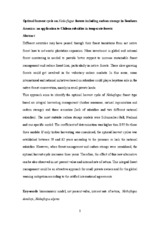Mostrar el registro sencillo del ítem
Optimal harvest cycle on Nothofagus forests including carbon storage in Southern America: an application to Chilean subsidies in temperate forests
| dc.contributor.author | Moreno, Norman | |
| dc.contributor.author | Moreno, Roberto | |
| dc.contributor.author | Molina, Juan Ramón | |
| dc.date.accessioned | 2024-02-02T13:21:23Z | |
| dc.date.available | 2024-02-02T13:21:23Z | |
| dc.date.issued | 2018 | |
| dc.identifier.uri | http://hdl.handle.net/10396/27016 | |
| dc.description.abstract | Different countries may have passed through their forest transitions from net native forest loss to net exotic plantation expansion. More investment in global and national forest monitoring is needed to provide better support to increase sustainable forest management and reduce forest loss, particularly in native forests. These slow-growing forests could get involved in the voluntary carbon markets. In this sense, some international and national initiatives based on subsidies could play a keystone role in the native forest conservation, mainly in small private lands. This approach aims to identify the optimal harvest cycle of Nothofagus forest type based on integral harvesting management (timber resources, natural regeneration and carbon storage) and three scenarios (lack of subsidies and two different national subsidies). The most suitable carbon storage models were Schumacher-Hall, Naslund and one specific model. The coefficient of determination was higher than 0.95 for these three models. If only timber harvesting was considered, the optimal harvest cycles was established between 59 and 62 years according to the presence or lack the national subsidies. However, when forest management and carbon storage were considered, the optimal harvest cycle increases three years. Therefore, the effect of this new alternative can be also observed in net present value and internal rate of return. This integral forest management could be an attractive approach for small private owners and for the global warning mitigation according to the ratified international agreements. | es_ES |
| dc.format.mimetype | application/pdf | es_ES |
| dc.language.iso | eng | es_ES |
| dc.publisher | Elsevier | es_ES |
| dc.rights | https://creativecommons.org/licenses/by-nc-nd/4.0/ | es_ES |
| dc.source | Moreno, N. B., Moreno, R., & Molina, J. R. (2019). Optimal harvest cycle on Nothofagus forests including carbon storage in Southern America: an application to Chilean subsidies in temperate forests. Land Use Policy, 81, 705-713. https://doi.org/10.1016/j.landusepol.2018.10.026 | es_ES |
| dc.subject | Bioeconomic model | es_ES |
| dc.subject | Net present value | es_ES |
| dc.subject | Interest rate of return | es_ES |
| dc.subject | Nothofagus dombeyi | es_ES |
| dc.subject | Nothofagus alpina | es_ES |
| dc.title | Optimal harvest cycle on Nothofagus forests including carbon storage in Southern America: an application to Chilean subsidies in temperate forests | es_ES |
| dc.type | info:eu-repo/semantics/article | es_ES |
| dc.relation.publisherversion | https://doi.org/10.1016/j.landusepol.2018.10.026 | es_ES |
| dc.rights.accessRights | info:eu-repo/semantics/openAccess | es_ES |

